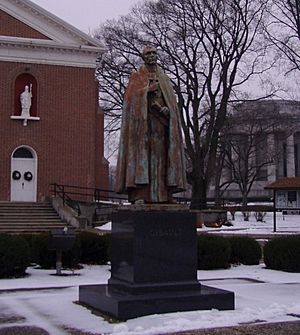Pierre Gibault facts for kids
Father Pierre Gibault (born April 7, 1737 – died August 16, 1802) was a Jesuit missionary and priest. He lived in the 1700s in the area known as the Northwest Territory (which is now parts of the Midwest United States). He was also an American Patriot during the American Revolution. This means he supported the American fight for independence from Great Britain.
A Missionary on the Frontier
Pierre Gibault was born in Montreal on April 7, 1737. He became a priest in Quebec on March 19, 1768. Soon after, he was made the Vicar General for the Archbishop of Quebec. This meant he was a main leader for the Catholic Church in the Illinois Country.
In 1763, France lost the Northwest Territory to Great Britain. Because of this, Jesuit priests were forced to leave. Catholic communities then had to rely on local people to lead their churches.
In July 1768, Father Gibault arrived in Michilimackinac. He helped Catholics there, some of whom had not seen a priest in many years. On September 8, 1768, he arrived in Kaskaskia. He served French and Native American Catholics. He also helped soldiers from the 18th Royal Irish Regiment.
Father Gibault first visited Vincennes in 1769. A large crowd greeted him, asking for his help. He traveled a lot, overseeing churches in places like Vincennes, Kaskaskia, Ste Genevieve, and Cahokia. He also visited other settlements like Ouiatenon and Peoria. The frontier was a dangerous place back then. Father Gibault even carried a gun and two pistols for safety.
In 1770, he blessed a small wooden chapel in Paincourt. This place is now known as St. Louis. Father Gibault held many masses and baptisms there. He continued until 1772, when another priest arrived to live there.
The Patriot Priest
In 1778, George Rogers Clark arrived in Kaskaskia. Clark was an American military leader. Father Gibault told Clark that he supported the Americans. But he was worried about his Catholic community. Clark promised him that they would be free to worship as they wished. Clark also told Gibault about the new treaty between the United States and France.
Father Gibault convinced the French-speaking residents to support the Americans. He also persuaded them to accept American paper money. He often traded Spanish money for American notes. By 1783, this had cost him a lot of money. Father Gibault and a Spanish trader named Francis Vigo helped fund much of the Illinois campaign. This was a key part of the American Revolution.
Clark wanted to take Vincennes. But Father Gibault said he could do it without soldiers. On July 14, 1778, Father Gibault and Dr. Jean-Baptiste Laffont left Kaskaskia. They convinced most of the people in Vincennes to support the American cause. The people then raised a new American flag at Fort Sackville. They threw the British flag into the Wabash River. Gibault returned to Kaskaskia to tell Clark the good news.
Later, British Lt-Governor Henry Hamilton took back Fort Sackville. He also captured Captain Leonard Helm. Father Gibault was then confined to Vincennes. Hamilton also captured Francis Vigo, who was a Spanish citizen.
Father Gibault led his whole church to Fort Sackville after Sunday mass. He told Hamilton that no supplies would be given to the fort until Vigo was freed. Vigo was released and told Clark about Vincennes being captured. Gibault soon returned to Kaskaskia. He blessed American and Canadian forces led by Clark. They recaptured Vincennes in February 1779.
Because he helped the Americans, other priests did not like Father Gibault. They had stayed loyal to the British government. In 1788, Father Gibault asked to move to Quebec. But the Bishop said no. This was because the government had a bad opinion of him.
In 1790, Father Gibault wrote a letter to Arthur St. Clair. He explained his services and the money he was owed. He asked that some land in Kaskaskia, used by priests, be given to him and future priests. President George Washington approved this request. But the new American Bishop disagreed.
Without land or money, Father Gibault moved to New Madrid, Missouri. He served the church there until he died on August 16, 1802. His body was sent to Canada, but his grave is not marked.
Honoring Father Gibault
Several things are named after Father Gibault:
- The ship USS Pierre Gibault was named for him.
- Gibault Catholic High School in Waterloo, Illinois is named after him.
- Gibault, Inc., also known as Gibault Children's Services, helps children in Terre Haute, Indiana. It was founded in 1921.
- Good Samaritan Hospital in Vincennes, Indiana built a new part called Gibault Memorial Towers.
Father Gibault was also featured on a special coin. This coin celebrated 200 years of Indiana statehood.



